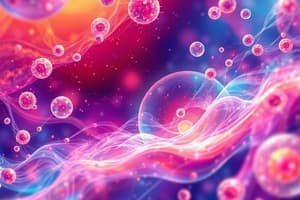Podcast
Questions and Answers
What is the diameter of microtubules?
What is the diameter of microtubules?
- 8nm
- 10nm
- 25nm (correct)
- 15nm
Which protein filament is thinner than microtubules?
Which protein filament is thinner than microtubules?
- Microtubules
- Intermediate filaments
- Microfilaments
- Actin filaments (correct)
What are microfilaments made from?
What are microfilaments made from?
- Tubulin
- Actin (correct)
- Collagen
- Keratin
What are intermediate filaments made from?
What are intermediate filaments made from?
Which cytoskeletal protein filament is described as long tubes?
Which cytoskeletal protein filament is described as long tubes?
What is crucial for the function of many highly specialized cells?
What is crucial for the function of many highly specialized cells?
Which cellular process involves the movement of molecules and organelles within the cell?
Which cellular process involves the movement of molecules and organelles within the cell?
What aspect of the cytoskeleton allows it to respond to changes in cell shape?
What aspect of the cytoskeleton allows it to respond to changes in cell shape?
What is NOT a function of the cytoskeleton?
What is NOT a function of the cytoskeleton?
In which type of cells is the super-elongated form like neurons often observed?
In which type of cells is the super-elongated form like neurons often observed?
Why do cells need to be motile?
Why do cells need to be motile?
What is the primary function of motile cells in host defense?
What is the primary function of motile cells in host defense?
What contribution does uncontrolled cell migration make to cancer?
What contribution does uncontrolled cell migration make to cancer?
How does the cytoskeleton support the cell shape?
How does the cytoskeleton support the cell shape?
What is a function of the cytoskeleton besides providing cell shape?
What is a function of the cytoskeleton besides providing cell shape?
Which cellular component is responsible for cells being able to sense their environment?
Which cellular component is responsible for cells being able to sense their environment?
What is the main function of the cytoskeleton within a cell?
What is the main function of the cytoskeleton within a cell?
Which of the following is NOT a component of the cytoskeleton mentioned in the text?
Which of the following is NOT a component of the cytoskeleton mentioned in the text?
Which group of proteins are responsible for cell movement mentioned in the text?
Which group of proteins are responsible for cell movement mentioned in the text?
How does the cytoskeleton contribute to the rigidity of a cell?
How does the cytoskeleton contribute to the rigidity of a cell?
Which evolutionary event was accompanied by the emergence of a system that positioned and anchored cell organelles?
Which evolutionary event was accompanied by the emergence of a system that positioned and anchored cell organelles?
What is the function of filaments in the cytoskeleton?
What is the function of filaments in the cytoskeleton?
How do accessory proteins contribute to the cytoskeleton?
How do accessory proteins contribute to the cytoskeleton?
What does the cytoskeleton primarily consist of?
What does the cytoskeleton primarily consist of?
Which term best describes the 3D structure formed by protein filaments in the cytoskeleton?
Which term best describes the 3D structure formed by protein filaments in the cytoskeleton?
Besides providing rigidity, what other function do the filaments in the cytoskeleton serve?
Besides providing rigidity, what other function do the filaments in the cytoskeleton serve?
Flashcards are hidden until you start studying
Study Notes
Cytoskeleton: Structure and Function
- The cytoskeleton is composed of three groups of protein filaments: microtubules, intermediate filaments, and actin filaments, which vary in size (25nm, 8nm, and 10nm external diameter, respectively).
- These protein filaments are polymers made up of protein sub-units.
Functions of the Cytoskeleton
- The cytoskeleton provides structural support to the cell, allowing it to change shape and move.
- It plays a crucial role in the segregation of internal cellular elements, such as organelles or proteins, and their relative position to one another.
- The cytoskeleton enables transport of molecules and organelles within the cell, as well as the movement of the cell as a whole.
Importance of Cell Motility
- Cell motility is essential for various biological processes, including:
- Neutrophil (macrophage) migration to chase bacteria
- Cell migration during development to reach defined locations
- Host defense against pathogens
- Wound healing through the secretion of extracellular matrix (ECM) proteins
Why Study Cell Migration?
- Uncontrolled cell migration contributes to several pathologies, including:
- Vascular diseases
- Chronic inflammatory diseases
- Cancer (tumor formation and metastasis)
Basis of Cell Migration
- The cytoskeleton, composed of fibers that dynamically reorient, shrink, and grow, is the basis of cell migration.
- This mechanism allows for:
- Axon growth and connection in neurons
- Muscle cell contraction and force production
- Cell division during mitosis
- Formation of filopodia to sense the environment
Cytoskeleton and Cell Architecture
- The cytoskeleton forms the architecture and transport system of the cell, providing:
- Structural support and shape
- Transport of cargo-filled vesicles, individual molecules, and cell organelles
- Positioning and anchoring of cell organelles
Cytoskeleton: Movers and Shapers
- The three main groups of shapers (protein filaments) are:
- Microtubules
- Intermediate filaments
- Actin filaments
- The three main groups of movers (motor proteins) are:
- Kinesin
- Dynein
- Myosin
Studying That Suits You
Use AI to generate personalized quizzes and flashcards to suit your learning preferences.





